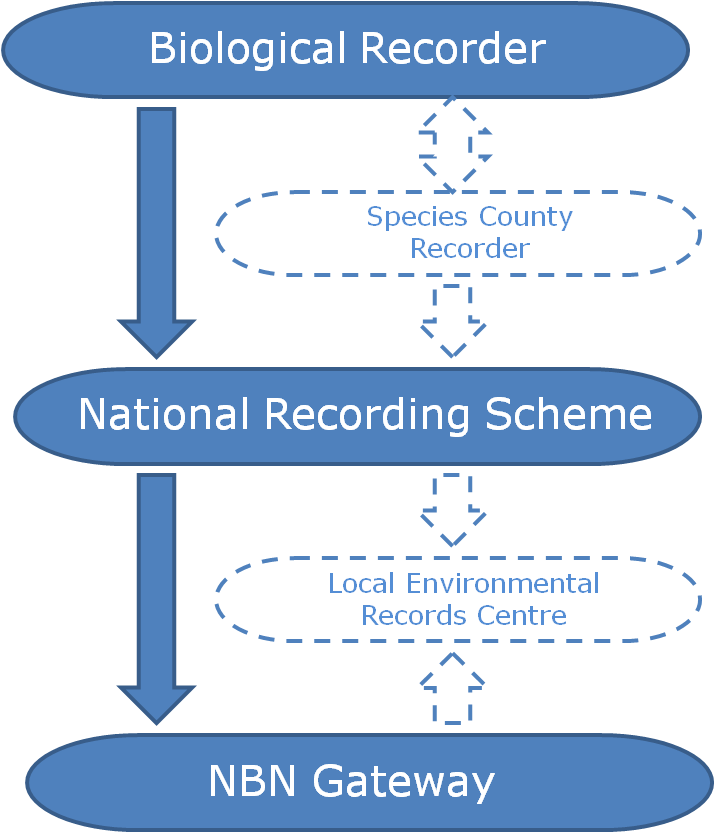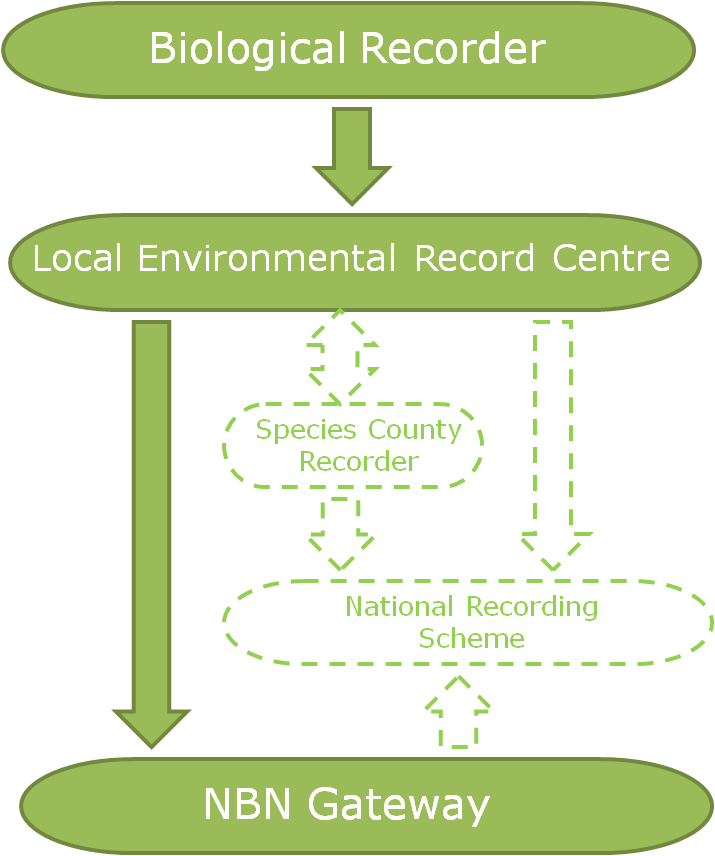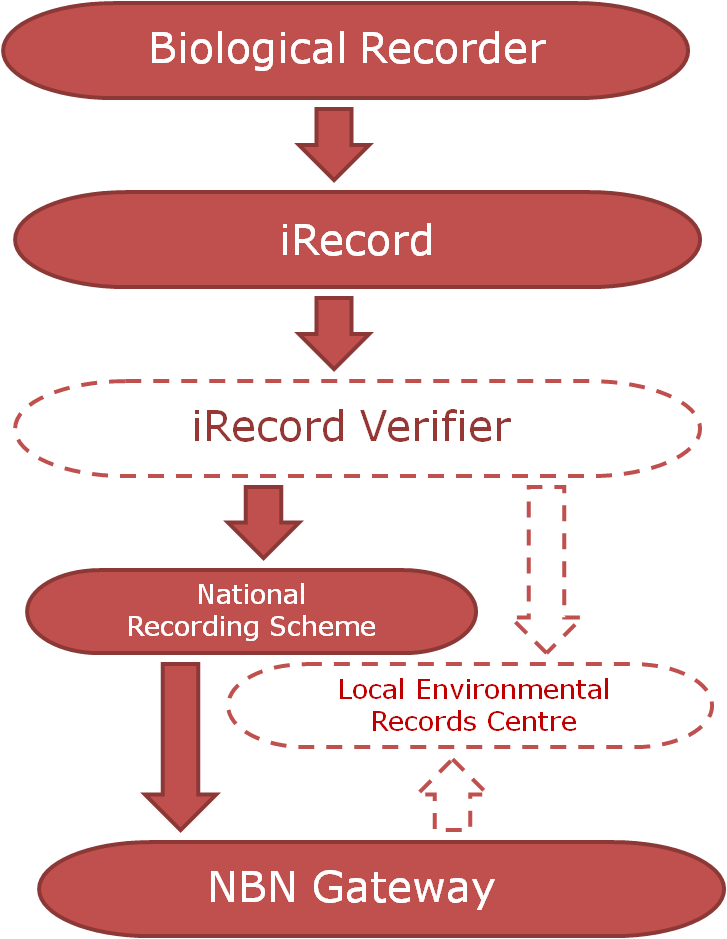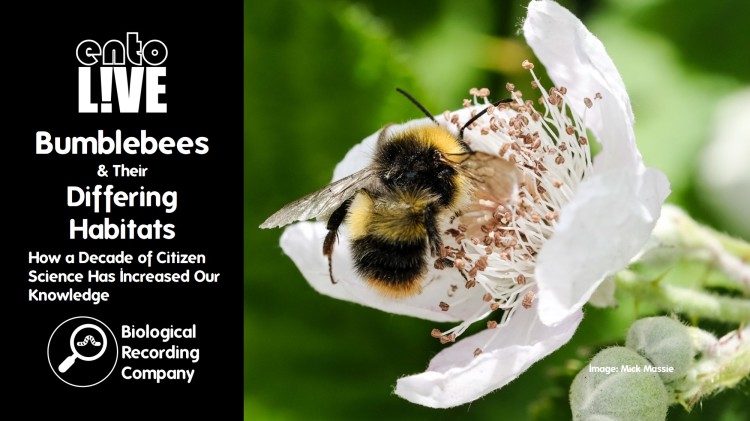By sharing biological records it opens up the potential benefit that a record can have to nature and the environment through analysis, research and the production of resources (such as a distribution atlas). Throughout the years, the number of organisations involved in the collection and dissemination of biodiversity data has increased and diversified, leaving biological recorders in a state of confusion as to who they should be sending their data too.
The ‘Endgame’
The best place to start with data flow is the end of the story, mainly because this is where the record’s use really comes into its own. The National Biodiversity Network Gateway is the UK’s depository for biological records (in Scotland this is the Atlas of Living Scotland). It houses many different data sets from many different organisations. These data sets may vary a lot in structure so they are accompanied by metadata (this is a description of the data set created by the data provider). One of the components of the metadata explains who the data set is available to (e.g. everyone, only government agencies or only those permitted by the provider) and what it can be used for (e.g. anything, non-commercial use or only by permission of the provider). Therefore, the NBN Gateway should be a one stop shop for all biological records and this is where we should aim to for our records to end up so they can be put to good use by scientists and conservationists.
So we just need to submit our records to the NBN Gateway? Unfortunately, it’s not that simple. Biological records are much more useful if they are validated and verified by appropriate experts and this is where things get a little more complicated. Below are three explanations of possible routes to the NBN Gateway. Please note that things differ regionally and between species groups so always contact the relevant organisations if you want to clarify what the best option is for any given record. Furthermore, records created for a specific survey should always be sent to the survey organiser (for example, records for surveys conducted as part of The Wider Countryside Butterfly Survey should always be sent to the UK Butterfly Monitoring Scheme).
Remember that you are the one creating the record so it is up to you where you send it to and you should base this on what you want your record to be used for. There is no right or wrong option and you may chose to send your records to multiple organisations to ensure it reaches all the relevant organisations (though this may lead to duplication on the NBN Gateway).
The species record perspective: National Recording Schemes and national surveys
If you would like the record to be used for distribution atlas production or species population trend monitoring, you should submit your record to the National Recording Scheme (NRS) for that species group. The NRS may be able to use your record to help improve the current knowledge about habitat preferences or behaviour, and will pick up on lesser known rare species. In essence, they are best placed to interpret your record in relation to the species group it belongs to.
You may need to contact the NRS to determine the best method to do this, as different surveys/schemes have different methods and preferences. Some will have a regional contact, a county recorder, that is responsible for collating the records in the local area and they will send your record on to the NRS alongside other species records.
Most NRSs will forward their data on to the NBN Gateway (depending on the NRS’s opinion of how their records should be used). From there it can be downloaded by Local Environmental Record Centres (LERCs), though there is no guarantee that this will happen. Some NRSs do pass on their records to LERCs but, as many NRSs are volunteer run, they do not always have the capacity to do so.
Pro: Species experts able to use data to better understand the ecology, distribution and conservation status of their species groups.
Cons: No guarantee that data will make it to LERCs to be used by managers of local habitats and local significance of species records may be lost.
The local record perspective: LERCs and local groups
I f you would like the record to be considered when decisions are made regarding the area the record was made in, you should submit your record to the LERC for the area the record originates from. The local knowledge of LERCs mean that they are best placed to interpret the significance of your record locally (in particular, looking at the importance of species assemblages), though this may not be picked up for lesser known species groups due to a lack of species-specific knowledge. They are also pivotal in disseminating local records to decision makers such as planners and government agencies.
f you would like the record to be considered when decisions are made regarding the area the record was made in, you should submit your record to the LERC for the area the record originates from. The local knowledge of LERCs mean that they are best placed to interpret the significance of your record locally (in particular, looking at the importance of species assemblages), though this may not be picked up for lesser known species groups due to a lack of species-specific knowledge. They are also pivotal in disseminating local records to decision makers such as planners and government agencies.
As with the species perspective, there may be a county recorder allocated for the species group that you would be redirected to (or they would pass your records on to them for processing).
Most LERCs will forward their data on to the NBN Gateway (although there is variation between LERCs as to how much and at what resolution data is shared, and who is granted access to LERC-submitted data). From there it can often be downloaded by NRSs, though this is unlikely to occur for most NRSs due to the fact that most recording scheme organisers are volunteers and would simply not have the time to do this. Some LERCs do pass on their records to NRSs (mainly through county recorders) but LERCs continue to be reduced in capacity by funding cuts and some may charge for all data searches/dissemination they conduct.
Pros: LERC able to put species records in local context and provide assistance to decision makers for local sites.
Cons: Records for lesser known groups may be overlooked and no guarantee that data will go to NRS where it can be interpreted alongside other records for the species.
The multi-taxa recorder perspective: iRecord
 The two routes above consider the use of the record and there are valid arguments for both routes. So why not send all of your records to both the relevant NRS and the LERC? Well, ideally that’s the best option but it’s not always pragmatic for a biological recorder to be able to do this due to the amount of administration that would entail. In fact, even just sending your records to several different LERCs or NRSs can be an administration mountain!
The two routes above consider the use of the record and there are valid arguments for both routes. So why not send all of your records to both the relevant NRS and the LERC? Well, ideally that’s the best option but it’s not always pragmatic for a biological recorder to be able to do this due to the amount of administration that would entail. In fact, even just sending your records to several different LERCs or NRSs can be an administration mountain!
One solution to this is iRecord. This is an online biological record submission platform created by the Biological Records Centre and the NBN to simplify things for the recorder. The idea is that you can use one system to input all of your records and the relevant NRS and LERC can access that. Furthermore, iRecord allows survey and scheme organisers to create their own forms so iRecord can allow for the vast differences between what different surveys will ask you to record, though all records will still require the basics: who, what, where, when
iRecord relies on a registered species group verifier to check species records to ensure that only reliable records are accepted. Verifiers may be county recorders or scheme/survey organisers, and are usually a representative of the relevant NRS. LERCs are able to download both verified and unverified data for their area from iRecord. iRecord verifiers can set up filters so that records are automatically accepted for certain easy-to-identify species (e.g. hedgehog).
Pros: Provides the recorder with an online database of their records and reduces administration workload of recorder (and often the verifier too). Allows NRSs to receive records from multi-taxa recorders that may not otherwise engage with the NRS.
Cons: Not all species groups have an active verifier assigned and those records remain unverified. No guarantee that LERC will download local records.
Conclusion
There is no doubt that data flow is a complicated topic and it’s no surprise that biological recorders are often left confused about where they should send their records. There is no right or wrong submission pathway to send your data to as they all have their pros and cons. The best way to decide is to think about what you want your record to be used for and contact the relevant organisation(s) to see what they recommend. You may find that some organisations have developed a data flow pathway that ensures that your record will go to everyone who can put it to good use. Regardless of where you send it, the most important thing is that you engaged with nature by making a record in the first place.
Keiron Derek Brown
20th March 2016











Reblogged this on educatingducks and commented:
A useful (if simplified) view of the path of biological records.
LikeLike
A good breakdown of a fascinating subject matter. Thanks, Keiron.
Best Wishes
Tony Powell and naturestimeline
LikeLike
Thank you Tony
LikeLiked by 1 person